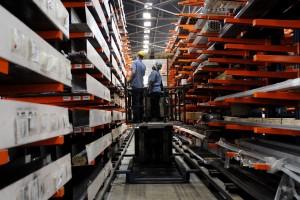Why tuning your supply chain to demand signals and improving visibility can deliver big rewards.
 With the advent of social media, mobile technology and ubiquitous access to information across every imaginable channel, the age of the customer has arrived. Today, customers are in the driver’s seat and the rules of the business game have changed. Those changes extend to your supply chain. Today, success is all about responding to customer demand as quickly and efficiently as possibly, sometimes before customers are aware of it (think latent or pent-up demand).
With the advent of social media, mobile technology and ubiquitous access to information across every imaginable channel, the age of the customer has arrived. Today, customers are in the driver’s seat and the rules of the business game have changed. Those changes extend to your supply chain. Today, success is all about responding to customer demand as quickly and efficiently as possibly, sometimes before customers are aware of it (think latent or pent-up demand).
If you’re a logistics executive, this new business model means aligning your supply chain with actual demand rather than forecasted demand. In so doing, you can minimize disruptions, costs and delays and get products to market when, where and how your customers want them. It also means transforming your existing supply chain into one that deftly aligns planning, procurement, production and inventory replenishment with true consumption and demand.
By doing away with old notions of top-down supply chain management and taking a more transparent, integrated and connected approach that synchronizes stakeholders across your network, worries about out-of-stocks, lost sales, inventory pileups, poor capacity utilization and declining service levels become a thing of the past.
What is a demand-driven supply chain?
A demand driven supply chain (DDSC) delivers real-time information about demand and inventory levels to every stakeholder in the network, enabling immediate and effective response to unexpected change (think spikes or drops in demand or a retail promotion that drives a surge in demand).
Here are some of the characteristics of a demand-driven supply chain:
- Product movements are driven by actual rather than forecasted demand
- Partners at every tier of the supply chain have visibility into product movement
- Inventory levels are tuned to desired operating levels
- Potential issues are identified well before they impact production
- The system reacts to demand signals across customers, suppliers & employees
Why do I want a demand-driven supply chain?
The real question is why wouldn’t you? According to The Boston Consulting Group, companies with demand-driven supply chains carry a third less inventory, improve delivery performance by 20 percent, and are able to dramatically reduce supply chain costs.
Four secrets to a demand-driven supply chain:
Setting up a demand-driven supply chain requires a more sophisticated technology infrastructure, smarter data collection, improved operations, aligned metrics and incentives, better management of costs and service tradeoffs and recalibrating organizational and staff behavior. Here are four secrets to making it happen:
- Improved visibility. Access to real-time information on current demand and inventory levels, enabling supply chain participants to react quickly and effectively by revising forecasts or changing production/distribution schedules.
- Robust infrastructure: that allows supply chain partners to adapt quickly to short-term changes in supply and demand. This includes a fast data-exchange platform that enables inventory data to be shared in real time among participants, strong processing capabilities, a trusted data storage solution and automated processes.
- Tight coordination: between supply chain stakeholders, enabling companies to execute flawlessly and cost-effectively, minimizing out-of-stocks or excess inventory, lost sales and the high cost of expediting orders. This also means aligning financial and performance metrics on an enterprise-wide basis.
- Optimization. By optimizing supply chain processes and performance, companies can deliver exceptional customer service without compromising the bottom line. Cost-reduction efforts are always considered within the context of their bottom-line impact of service levels, manufacturing flexibility and inventory levels.
Could you benefit by transforming your traditional supply chain into a streamlined, demand-driven one? To learn more about the six pillars of demand-driven supply chain success, read The Boston Consulting Group’s study, “The Demand-Driven Supply Chain. Making It Work and Delivering Results.”
Written by Michael Rackley, Senior Director of Product Completion, Ryder Supply Chain Solutions
Michael Rackley is Senior Director of Product Completion for Ryder Supply Chain Solutions. In his role, he is responsible for designing plant layouts, engineering specifics, demand planning requirements, shop floor requirements as well as creating awareness for the product completion center solution. Mr. Rackley joined Ryder in 2004 and since then has held various positions of increasing responsibility. Prior to joining Ryder, he worked as the Director of Quality for Lego Systems for 2 years. Before Lego Systems, he worked for Coca Cola USA for 22 years in roles of increasing responsibility and eventually became their Corporate Director of Quality for US Facilities. Mr. Rackley earned a BS in Biology from Lubbock Christian University and an MS in Microbiology from Abilene Christian University. He was also certified as a Logistics Professional with Georgia Tech University.

